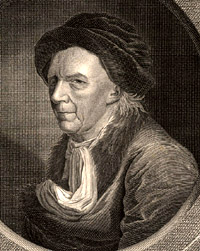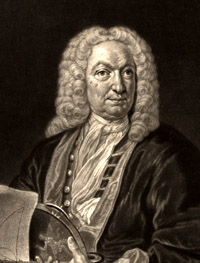Solving Linear Higher Order Differential Equations with Euler and Johann Bernoulli: A Mini-Primary Source Project for Differential Equations Students
The first general type of higher order differential equations solved in an undergraduate Ordinary Differential Equations course is homogenous, linear, and with constant coefficients. In other words, equations that can be put in the form \[0 = Ay+ B\frac{dy}{dx} + C\frac{ddy}{dx^2} + D\frac{d^3y}{dx^3} +\dots+ N\frac{d^ny}{dx^n}.\] Historically, this was also the first class to be solved! The mini-Primary Source Project (mini-PSP) Leonhard Euler and Johann Bernoulli Solving Homogenous Higher Order Linear Differential Equations With Constant Coefficients introduces students to that solution technique via excerpts from the correspondence and publications of its discoverer: Leonhard Euler (1707–1783).
On September 15, 1739, Euler wrote a letter to his friend and teacher “the most celebrated esteemed Sir Johann Bernoulli” (1667–1748). Euler corresponded often and with many people. Indeed, more than 2829 letters to and from Euler survive, many containing important results that would be published in the future and that we still use today. But it was in this particular letter that he shared the following discovery.
I have recently found a remarkable way of integrating differential equations of higher degrees in one step, as soon as a finite [algebraic] equation has been obtained. Moreover this method extends to all equations which . . . are contained in this general form:\[y +\frac{A \, dy}{dx}+\frac{B\, ddy}{dx^2}+\frac{C\, d^3 y}{dx^3}+\frac{D\, d^4 y}{dx^4}+\frac{E\, d^5 y}{dx^5} + \text{etc.}=0.\]
As a point of reference, Gottfried Leibniz (1646–1716) published the solution to first order linear differential equations in 1694, almost 50 years earlier. The conversation between Euler and Bernoulli concerning the higher order problem continued through an additional two letters; a December 9, 1739, response from Bernoulli in which he claimed to have been aware of such a result for years, and a January 19, 1740, letter in which Euler provided some additional details of the technique.1 While this correspondence is interesting and informative (and included in this project), the notation is inconsistent and, as Bernoulli complained, the method “lacks a demonstration.”


Portraits of the correspondents: Leonhard Euler (left) and Johann Bernoulli (right).
Convergence Portrait Gallery.
So, we jump a bit into the future. A polished version of the technique was published in Section 12 of Euler’s 1743 article “De integratione aequationum differentialium altiorum graduum” (“On the integration of differential equations of higher orders”) [Euler 1743]. There, he gave a demonstration of the method that any modern student would recognize. He assumed the solutions to the given differential equation have the form \(y=e^{\int p dx}=e^{px}\) and, upon substitution, produced an associated (or auxiliary) algebraic equation. Finding the roots \(p_1, p_2, p_3, \ldots, \) of that algebraic equation then gave rise to the solutions \(e^{p_1 x}, e^{p_2 x}, e^{p_3 x},\ldots\) of the given differential equation. Euler presented his method in four separate cases, taking care to explain how to combine the resulting (linearly independent) solutions to obtain a “complete integral equation" of the given differential equation:
- Distinct real roots of the algebraic equation;
- Repeated roots of the algebraic equation;
- Distinct complex roots of the algebraic equation; and
- Repeated complex roots of the algebraic equation.
This mini-PSP uses the primary sources described above to introduce the technique for solving homogenous higher order linear differential equations with constant coefficients. Euler's presentation of the general method and the cases of distinct and repeated real roots are provided verbatim from the original sources; his description is clear enough to replace any modern treatment. Euler’s justification of the complex cases is also included, but it is different from what we see in today’s textbooks. Thus, it may be pedagogically more helpful to ask students to simply show that the two methods agree, which the project prompts students to do through a series of tasks. Repeated complex roots are also noted (but not emphasized). A “modern” example of each case is provided for students to work through in the initial presentation of each case, with seven additional historical examples drawn from the primary sources supplied in a later section to provide students with further practice. These include “a suitable example" that Euler gave in his 1739 letter to Bernoulli to illustrate his method: the differential equation \(ydx^4 = K^4 d^4 y\), which arises in the study of the vibration of an elastic lamina with one end fixed to a wall (a flat version of the I-beam image shown below). Indeed, on May 5, 1735, Daniel Bernoulli (1700–1782), the son of Johann, wrote to Euler, "For the curve [of the vibrating elastic lamina] I find the equation \(nd^4y = y dx^4\) . . . but this matter is very slippery” (as quoted in [Cannon and Dostrovsky 1981, p. 70]). At that time (4 years before he shared his closed-form solution method with Johann), Euler reported that he was only able to solve this equation in series form, an indication of how slippery the matter actually is.

An elastic I-beam. Animation by Lzyvzl at en.wikipedia, CC BY-SA 3.0, via Wikimedia Commons.
After working through the derivations and examples in the project, we hope students will be able to solve any differential equation of this type (with reasonable auxiliary equation). An historical epilogue to the project offers further context for the problem and the passages that students have read by briefly recounting how Euler's work on this particular class of differential equations led him to consider trigonometry as a study of functions—thereby turning sine and cosine into the trigonometric functions that have since been learned by centuries of high school and college math students!2
The complete project Leonhard Euler and Johann Bernoulli Solving Homogenous Higher Order Linear Differential Equations With Constant Coefficients (pdf) is ready for student use, and the LaTeX source code is available from the author by request. Instructor notes are provided to explain the purpose of the project and to guide the instructor through implementation of the project.
This project is the twenty-fourth in A Series of Mini-projects from TRIUMPHS: TRansforming Instruction in Undergraduate Mathematics via Primary Historical Sources appearing in Convergence, for use in courses ranging from first-year calculus to analysis, number theory to topology, and more. Links to other mini-PSPs in the series appear below. The full TRIUMPHS collection also offers dozens of other mini-PSPs and a similar number of more extensive full-length PSPs. These include six additional projects for use in a differential equations course.
Notes
[1] All three of these letters (and 14 more) were published in their original Latin by Gustaf Eneström (1852–1923) in a series of three articles in the early 20th century. Specific citations for each are as follows:
- September 15, 1739, first letter from Euler [Eneström 1905, pp. 33–38]
- December 9, 1739, Bernoulli response letter [Eneström 1905, pp. 38–43]
- January 19, 1740, return letter from Euler [Eneström 1905, pp. 43–52]
[2] See [Katz 1987] for details of the argument that Euler's recognition of the need for the trigonometric functions as solutions of linear differential equations was the influential factor in his invention of the calculus of those functions.
Acknowledgments
The development of the student project Leonhard Euler and Johann Bernoulli Solving Homogenous Higher Order Linear Differential Equations With Constant Coefficients has been partially supported by the TRansforming Instruction in Undergraduate Mathematics via Primary Historical Sources (TRIUMPHS) project with funding from the National Science Foundation’s Improving Undergraduate STEM Education Program under Grants No. 1523494, 1523561, 1523747, 1523753, 1523898, 1524065, and 1524098. Any opinions, findings, and conclusions or recommendations expressed in this project are those of the author and do not necessarily reflect the views of the National Science Foundation.
References
Cannon, John T., and Sigalia Dostrovsky. 1981. The Evolution of Dynamics: Vibration Theory from 1687 to 1742. New York: Springer-Verlag.
Eneström, Gustaf. 1905. Der Briefwechsel zwischen Leonhard Euler und Johann I Bernoulli [Teil] III, 1739–1746 (The Correspondence between Euler and Johann I Bernoulli Part III, 1739–1746). Bibliotheca Mathematica 6(3):16–87.
Euler, Leonhard. 1743. De integratione aequationum differentialium altiorum graduum (On the integration of differential equations of higher orders). Miscellanea Berolinensia ad incrementum scientiarum 7:193–242. English translation by Alexander Aycock available at the Euler-Kreis Mainz project.
Katz, Victor J. 1987. The Calculus of Trigonometric Functions. Historia Mathematica 14(4):311–324.